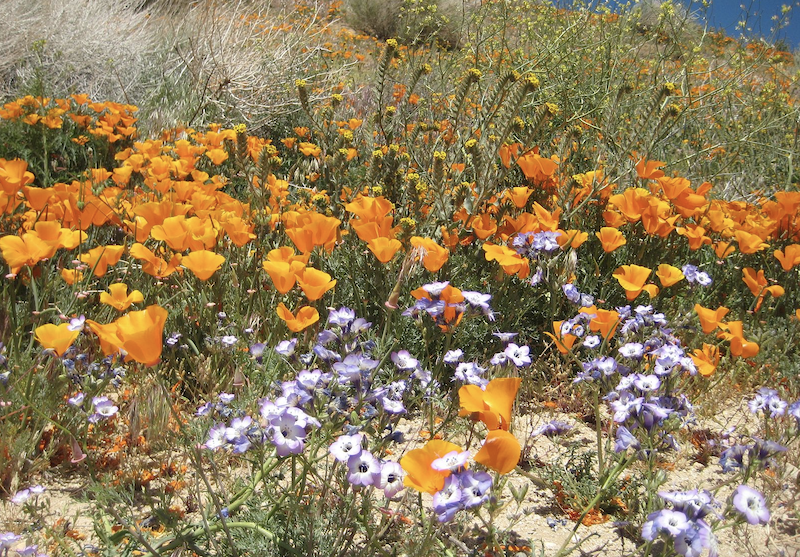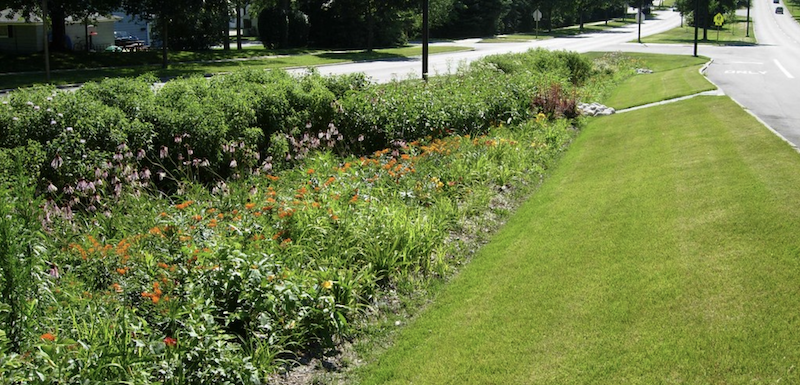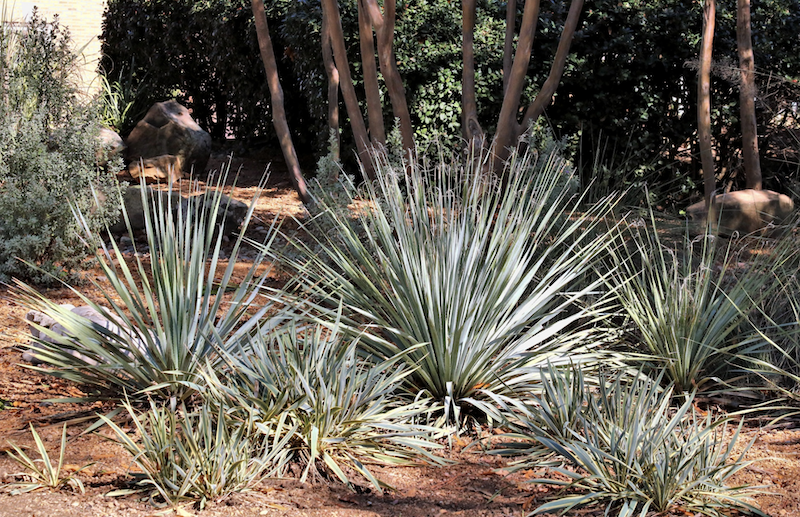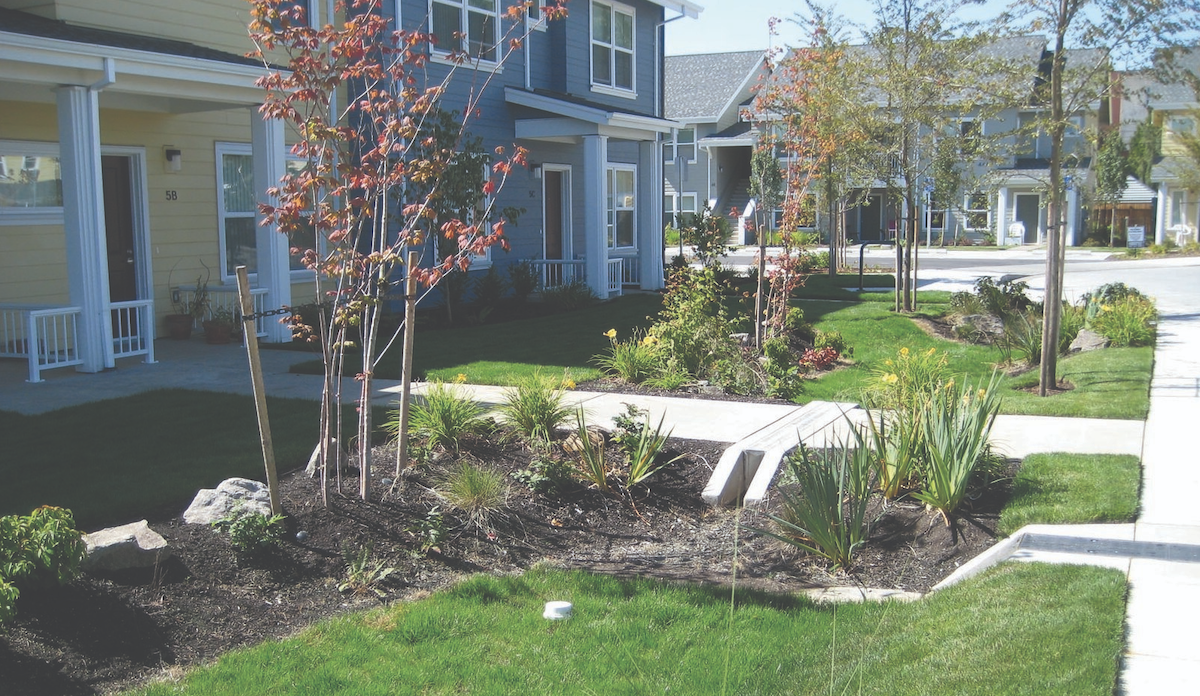Landscaping is a significant part of the built environment — a living, perishable part. Designing a low-maintenance landscape that preserves natural resources and is tailored to each site and climate is in the best interests of everyone connected with a residential project. Yet all too often, the landscape takes a back seat to the house. Part of the reason is that builders are still trying to wrap their heads around the idea of sustainable sites.
"There are people at the beginning, middle and end of the learning curve," says Chris Lannert, president of The Lannert Group, a land planning and landscape architecture firm in Geneva, Ill. "I think there are more at the finish line who understand it and realize that it's marketable and actually adds value."
Nancy Somerville, ASLA's executive vice president and CEO, says that water (both quantity and quality) is one of the biggest issues addressed by the SSI. "Every community in the nation is dealing with this," Somerville says. "And storm water runoff is an increasing problem because of the pollutant load it carries as well as its quantity and speed, which leads to erosion, streambed scouring and flooding in a lot of communities."Green certification programs address issues such as site orientation, tree preservation, erosion control and storm water management in broad strokes. However, more comprehensive guidelines are in the works. The Sustainable Sites Initiative (SSI), a partnership of the American Society of Landscape Architects (ASLA), the Lady Bird Johnson Wildflower Center at the University of Texas at Austin and the United States Botanic Garden, has developed a voluntary rating system for sustainable landscapes of all sizes.
Final benchmarks for the SSI will be published by the end of this year, followed by a call for pilot projects. Over the next 18 months, SSI partners and the U.S. Green Building Council will decide how to incorporate those standards into LEED.

Ultimately, one of the best things home builders and developers can do is get the entire design and construction team together early in the game, including the landscape architect. "Landscape kind of comes last, and it's sometimes not invested in very heavily," says Geoff Stack, a Baltimore-based project coordinator, landscape designer and educator. "More than any product or checklist or design technique, bringing everyone in and giving them the freedom to do what they do best is where you'll get the most bang for your buck."
Landscape design varies across the country, so we examine characteristics and best practices in projects from the five major climate zones in the United States, as defined by the U.S. Department of Energy.
Marine Climate: Private Residence, Portland, Ore.
On an urban site, landscape architect Deborah Tolman of Avant Gardens was challenged by a steep slope, compacted soil, lack of shade and storm water runoff directed toward the house and street. The homeowners wanted a sizable vegetable garden but needed to reduce their use of potable water for irrigation.
Tolman amended the soil with 25 cubic yards of compost and planted aspen trees in the backyard to ameliorate pesticide contamination in the soil. Downspouts were disconnected and replaced with two 55-gallon drums to collect rainwater for irrigation and eliminate storm water runoff from the driveway.
"We had to utilize a lot of compost because [the site] was a barren wasteland, not to mention the huge slope and lots of grass," says Tolman.
Existing vegetation was incorporated into the new design, along with native plants such as ferns, birches and willows. A dry well was built in the backyard underneath the lawn to capture and dissipate excess water into the ground.
Cold/Very Cold Climate: Pepper Creek, Valparaiso, Ind.
Pepper Creek itself serves as the backbone of a 150-acre property, with trails and other amenities branching off it. Mature woodlands encircle the property.
The Lannert Group of Geneva, Ill., created a master plan that protects the creek, minimizes site disturbance and retains existing vegetation. Crescent-shaped, serpentine boulevards with landscaped medians enhance water filtration. Lannert also reforested the back of each lot and designed storm water retention ponds.
Bioswales were seeded with a mixture of native grasses and sedges, including prairie dropgrass; little bluestem grass and porcupine sedge; and wildflowers such as blue flag iris, yellow coneflower and black-eyed Susan. Long, deep-rooted fescue grasses absorb large amounts of water and can be sprayed against invasive weeds. "From an earlier project, we learned there were things we could do to not only make the swales work better, but also to make them look prettier," says developer Jake Wagner of VJW Limited in Valparaiso, Ind.

Pepper Creek isn't typical of new-home developments in the Midwest, Wagner says. In lower-priced housing, a $10,000 landscaping allowance might be the equivalent of nothing more than a seeded lawn, which causes erosion and directs runoff into storm sewers.
Hot-Dry/Mixed-Dry Climate: Pacific Highlands Ranch, San Diego
At this Pardee Homes community, what had once been farmland was restored to the original habitat of arroyos, ravines and graded slopes. Rainwater percolates into the ground through permeable pavers at each driveway entrance. The streets drain into medians with curb cuts that allow water to flow into a dry creek bed, then into bioswales.
The recreational facility features permeable paving, synthetic turf, a solar shade trellis and a central irrigation control system that self-adjusts to seasonal weather variations. Front yards at Pardee communities include no more than 25 percent turf.

Hot-Humid Climate: Pontalba Street Residence, New Orleans
Brown+Danos LandDesign in Baton Rouge, La., landscaped this home in New Orleans as a demonstration project for the 2008 NAHB National Green Building Conference. Bioswales and rain gardens were constructed with a highly permeable engineered soil that allows infiltration of water. Native plant materials — iris, spider lily, dianella, umbrella plant, dwarf palmetto and adagio grass — were selected for their ability to tolerate the region's extremes of dry and wet weather. Mulches control weed growth and help retain moisture in dry periods.
Brown+Danos uses pervious pavement as often as possible to help dissipate water flow.
Mixed-Humid Climate: Private Residence, Loudon, Tenn.
To reduce the size of the lawn on the steeply sloped backyard of this home, Friendsville, Tenn., landscape architect Caron Beard terraced it with dry-stack rock walls, allowing rainwater to flow through instead of being channeled through pipes or concrete swales.
Beard plants rock walls with mostly native plants that have a long period of flowering and don't require a lot of water. At his own home, he reuses water from roof gutters and downspouts for irrigation. He advocates passive solar techniques, such as planting deciduous trees on the south side of a house to provide shade when it's hot and sun when it's cold.
New Ways to Green the Landscape
New products and technologies that enhance sustainable landscape design are emerging all the time. Here are a few examples:
HydraCX2. This hydromulch is made from mechanically processed straw fibers, reclaimed cotton plant material and performance-enhancing tackifiers (bonding agents). Developed by Mulch & Seed Innovations in Centre, Ala., along with Cotton Inc. and the USDA, it forms a protective matrix that holds soil and seed in place on steep slopes. Sprayed for the first time onto a residential hillside site in Copperas Cove, Texas, HydraCX2 produced grass within 15 days of installation, covering approximately 60 percent of the site. Despite high moisture levels, there was no discernible erosion, says Jason Orlando of Orsek Environmental Contractors in Temple, Texas.
Synthetic turf. Don’t call it Astroturf! This replacement for real turf grass doesn’t need irrigating, fertilizing, mowing or pesticides. The product is made by attaching PVC "blades" to a durable, porous backing. After being rolled out like carpeting over a bed of decomposed rock, sand and rubber crumbs are brushed into the turf to keep the blades upright.
“Artificial turf looks real,” says Greg Ray, vice president of landscape architecture for Pardee Homes in Los Angeles. “You can’t tell [it’s not grass] unless you pull on it. It’s readily available and is becoming more and more cost-effective.”
Membrane bioreactor (MBR) systems. An MBR system draws wastewater through hollow fibers with microscopic pores small enough to filter out particulate matter and even bacteria. This advanced technology will be used at Quarry Falls, an infill project in San Diego. “We’re planning a reclaimed water treatment plant on site that will take some of the liquids out of the sewer line, filter them and put them in a big underground storage tank, where they’ll be used for irrigation,” says Marco Sessa of Sudberry Properties, the developer.
Another technique that isn’t new, but may be unfamiliar to home builders outside California and the Southwest, is native revegetation — the restoration of desert habitats. Native desert plants don’t have to be irrigated and can survive on very little rainfall.
“Typically we’ll get out in front of the bulldozers and grab yuccas, Joshua trees, creosote bushes, bursage plants, cacti — any of the large, interesting material — and move it out of harm’s way,” says Jerry Stanley, president and founder of Soil-Tech, an environmental restoration services company based in Las Vegas.
“We set up a nursery on the site, nurture them until the dust settles and replant them.” Stanley says the cost is typically one-third to one-half that of conventional landscaping.

Homeowners Lack Knowledge of Green Yard Practices
According to a 2008 survey by the American Society of Landscape Architects (ASLA), many homeowners aren’t up to speed on the benefits of sustainable landscape practices — but they’d be willing to try if given more information. The survey, conducted online by Harris Interactive on behalf of ASLA, showed that while 96 percent of U.S. adults have adopted sustainable or energy-efficient practices inside the home, only 58 percent use energy- or water-saving techniques in their yard, lawn or garden.
Of those involved in the care of a residential yard, lawn or garden, only 29 percent planted shade trees to lower energy costs; 23 percent used maintenance methods that reduce fuel consumption, exhaust and emissions (such as using a rake instead of a leaf blower); 15 percent harvested rainwater or used recycled water to water plants; and 11 percent used drip irrigation.
The survey also examined these homeowners’ attitudes about sustainable landscape practices. Only 13 percent disagreed with the statement “I would use more ‘green’ yard practices if I knew more about them.” Sixteen percent disagreed with “Using ‘green’ practices in my yard takes little extra effort and time,” and 19 percent disagreed with “Using ‘green’ practices in my yard saves me money.”
“You probably see a similar gap in consumer awareness as you do with builders and some of the other groups in the design and construction industry,” says Nancy Somerville, ASLA’s executive vice president and CEO. Clearly, there is an opportunity here to enlighten both the housing industry and the public.
Additional resources:
EPA info on greenscaping for a healthier yard







